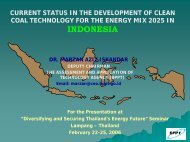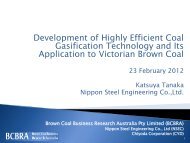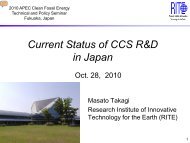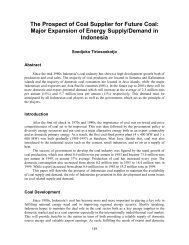Defining CCS Ready: An Approach to An International Definition
Defining CCS Ready: An Approach to An International Definition
Defining CCS Ready: An Approach to An International Definition
- No tags were found...
Create successful ePaper yourself
Turn your PDF publications into a flip-book with our unique Google optimized e-Paper software.
Appendix B: Technology Design Options for a Capture <strong>Ready</strong> Plantcombustion and the carbonate reaction, thus increasing the CO 2 concentration. It alsotypically has a high dust loading, as well as other contaminants from the combustionincluding SO 2 and NO x , and potentially others depending on the fuel. All of thesecontaminants would likely create problems for a CO 2 removal system.In locations with aggressive pollution control requirements, dust removal would likely be inplace already, and lower-sulfur fuel would be required, though possibly not <strong>to</strong> the levelrequired for a CO 2 capture system. NO x controls are less common. In regions with lessrigorous emission controls, the emissions might not be limited at all. This would probablyrequire significant additional investment in gas cleanup prior <strong>to</strong> the CO 2 capture system.There are some natural-gas-fired cement kilns, which would require less cleanup dependingon the <strong>to</strong>lerance of the CO 2 system.The other important consideration is that cement and lime manufacturing facilities do notrequire steam, and typically do not have boilers. If the CO 2 capture system requires steam,then a boiler and associated infrastructure would need <strong>to</strong> be installed at the site. Onealternative possibility would be <strong>to</strong> recover heat from the hot kiln exhaust <strong>to</strong> raise steam forthe CO 2 capture system; however a heat balance would need <strong>to</strong> be performed <strong>to</strong> seewhether this would be adequate. While this would avoid the cost of fuel, it would still be asignificant additional cost for the system.Oxy-fuel combustion might be another alternative, but could be challenging for severalreasons. First, it would be a very large additional operating expense for a product/businessthat has a very low margin and a high sensitivity <strong>to</strong> operating cost. Second, the kilns typicallyoperate with a very large amount of excess combustion air. Reducing the mass flow ofcombustion gas could require a significant redesign of the process and preclude retrofitapplications. That said, a major redesign of the calcining process could be a future approach<strong>to</strong> reducing the CO 2 from this important industry.B.4.3 Standard Combustion<strong>CCS</strong> from standard combustion in the industrial sec<strong>to</strong>r will likely rely on the sametechnologies available <strong>to</strong> the power sec<strong>to</strong>r (discussed above). The major differences willhave <strong>to</strong> do with the differences in facility configuration between typically industrial andpower generation facilities, including:Size: Industrial combus<strong>to</strong>rs are typically much smaller than those for power genera<strong>to</strong>rs. <strong>An</strong>industrial boiler with a heat input of over 100 MMBtu/hour is considered <strong>to</strong> be relativelylarge, yet this corresponds <strong>to</strong> a power plant boiler providing only 10 MW of power. Thereare very few industrial combus<strong>to</strong>rs as big as the boiler for a 100 MW power plant, whichwould be considered small for economic application of <strong>CCS</strong>. Some industrial facilities mayhave a large number of combus<strong>to</strong>rs, which in aggregate amount <strong>to</strong> a significant flow ofexhaust gas. However, bringing these streams <strong>to</strong>gether for processing could be mechanicallydifficult and expensive. The other implication of small size is the high cost of providing fortransport of the captured CO 2 <strong>to</strong> a s<strong>to</strong>rage facility. The cost of building a pipeline for a smallCO 2 volume would be very high on a per metric <strong>to</strong>n basis. In some cases, where there aremultiple facilities in one region, there could be the potential <strong>to</strong> aggregate the captured CO 2 .23 February 2010 98
















